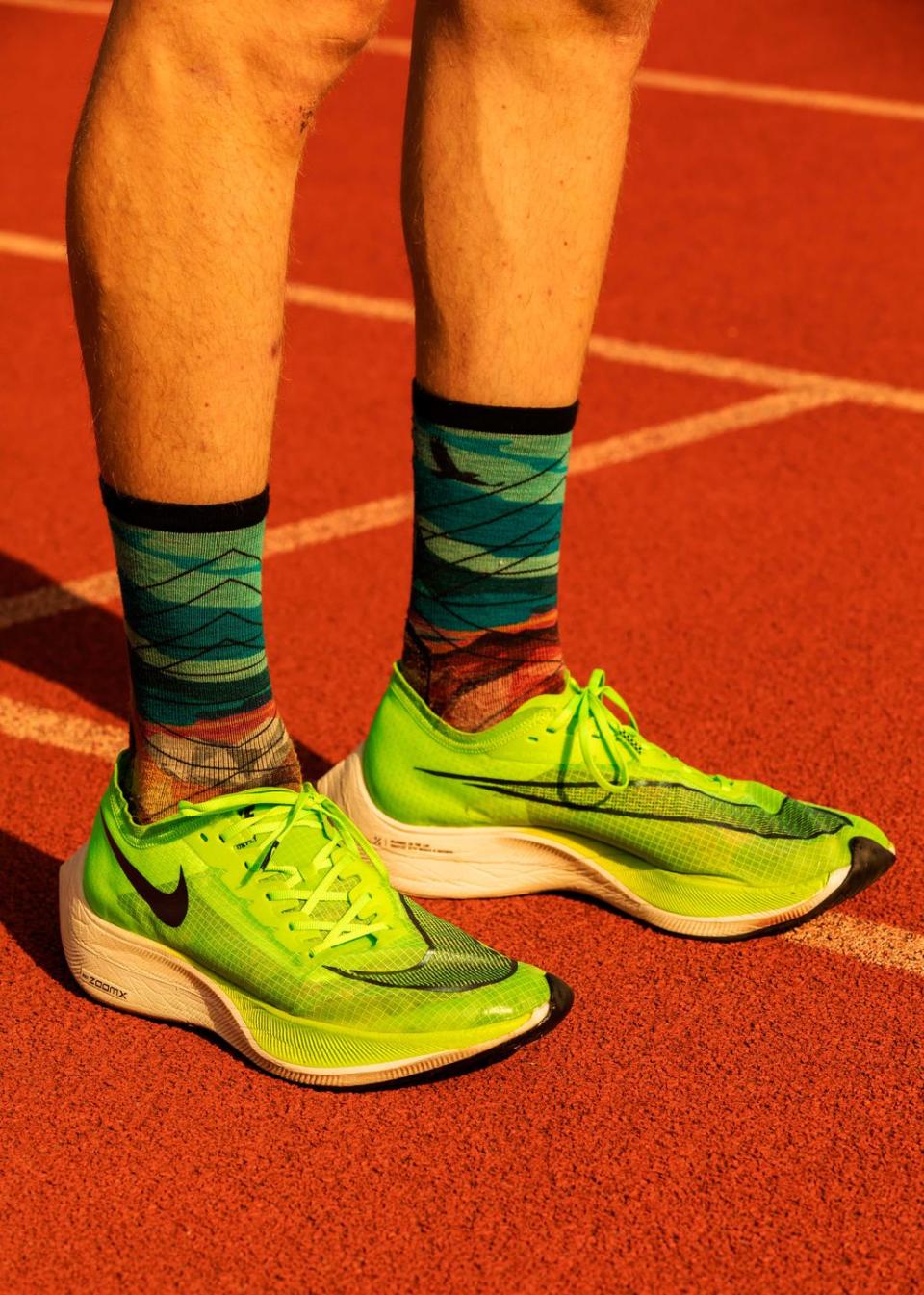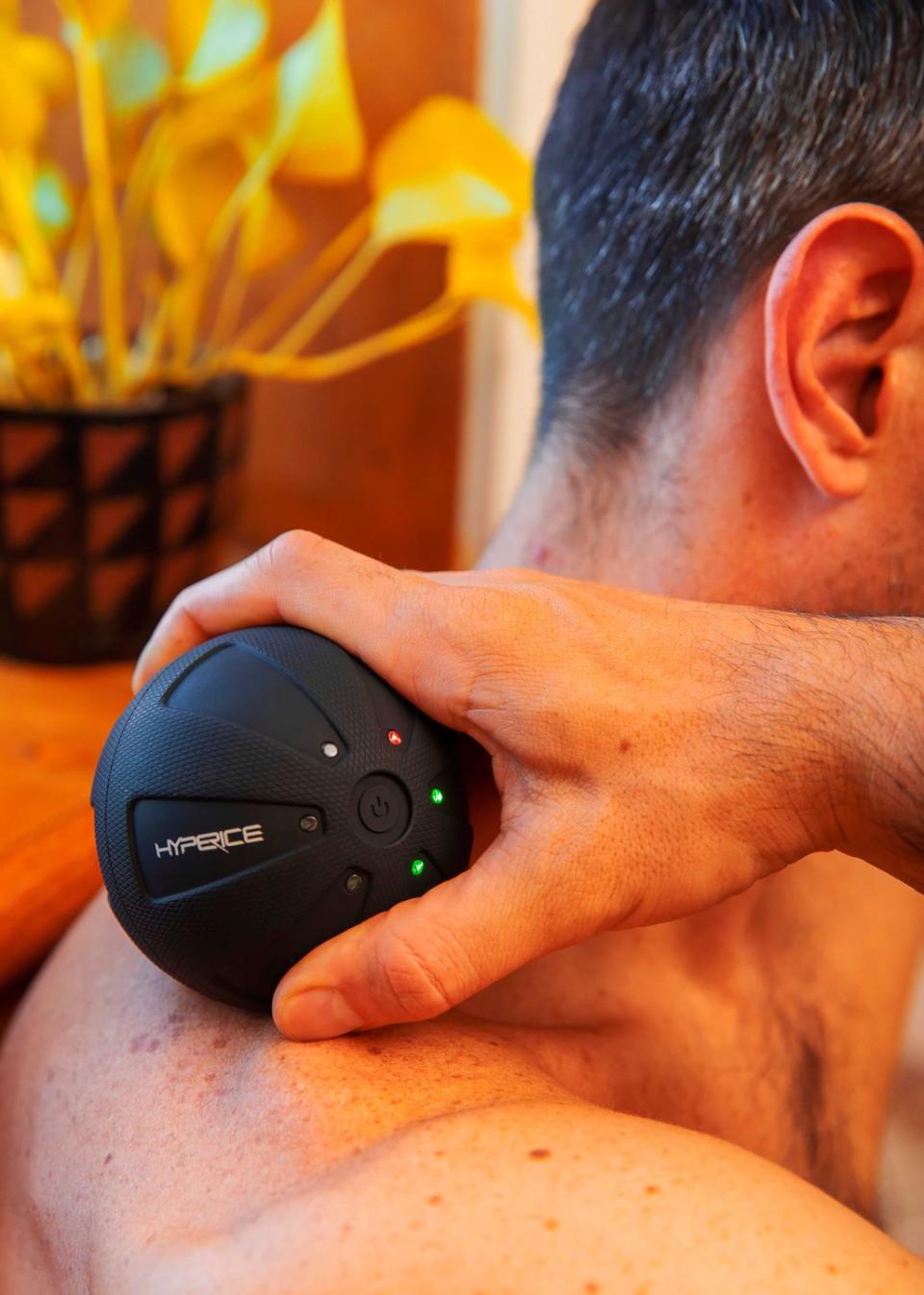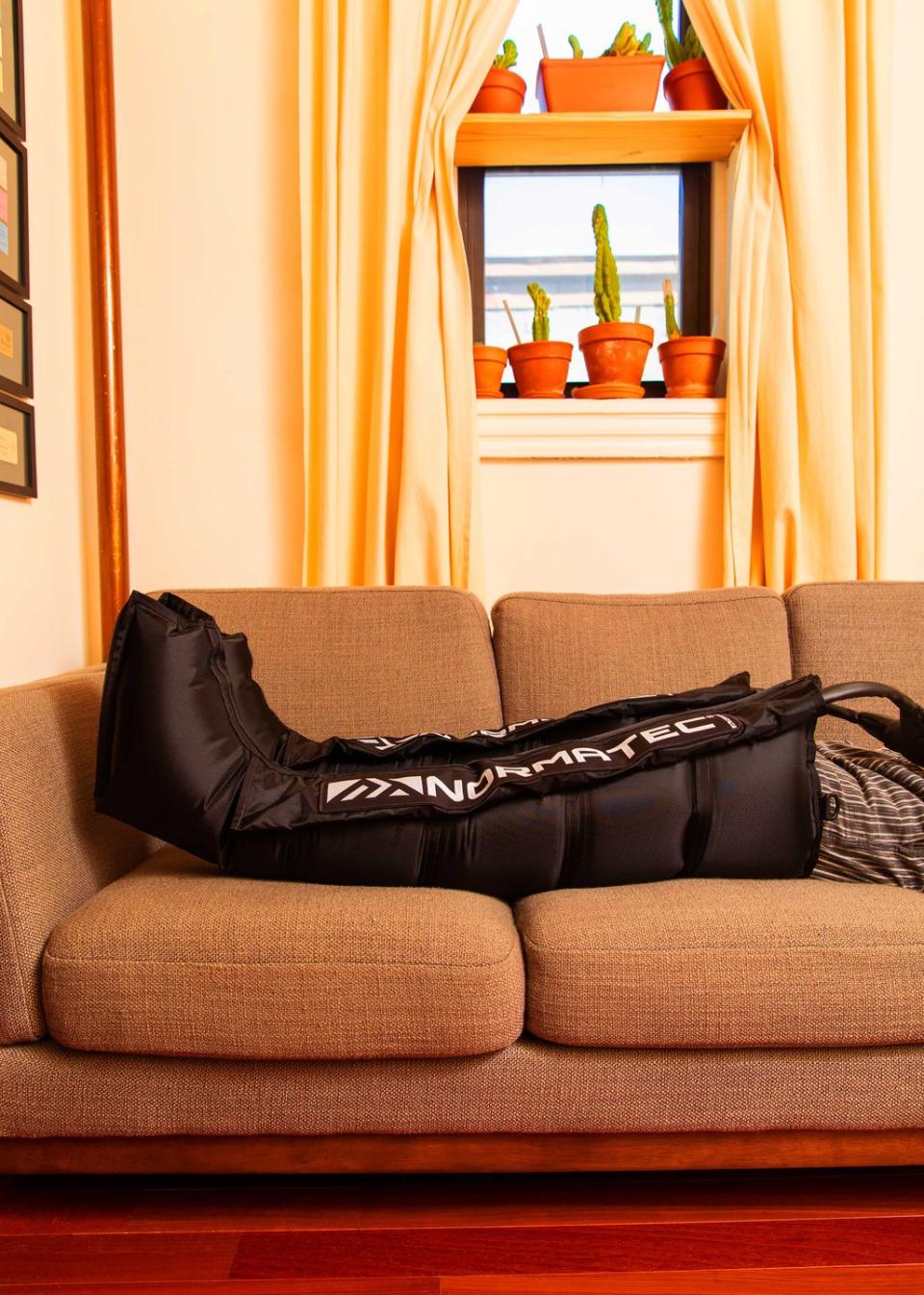10 Science-Backed Strategies to PR Your Next Marathon

There’s no shortcutting the big rocks of marathon training—miles, consistency, and progressive overload—but the next level of exercise science promises to unlock your full training potential. From tech and recovery to fueling and psychology, gold-medal marathoners, coaches, and researchers reveal the smart hacks that can help you meet (and surpass) your goals.
1. Stay Low to the Ground
In 2018, 64 percent of podium finishers in the Abbott World Major Marathons wore Nike Zoom Vaporfly 4% technology.

The Nike ZoomX Vaporfly NEXT% builds on the racers’ experience for even greater ground feel, proprioception, and ability to keep you moving forward, not up and down. “To truly hack the marathon, you need a shoe that limits vertical oscillation or bounce,” says Robyn LaLonde, Nike Running Coach. “A one-inch additional bounce when running equates to a half mile climb over the course of a marathon.”
Among this shoe’s other key features: 15 percent more ZoomX foam in the midsole and a less-absorbent upper.
2. Take a Nap
You might not be logging enough training to warrant quite as much sleep as Sir Mo Farah–he tells RW that he sleeps from around 10 pm to 7am and takes a two-hour nap in the afternoon—but science makes a strong case for a catnap. Adequate sleep improves how well your muscles store glycogen (quick-acting fuel), aids recovery, and lowers risk of injury. Most Americans get far fewer than the recommended seven to nine hours of sleep per night, but even a 20-minute nap increases time to exhaustion in runners that have gotten less than seven hours of sleep the night before, according to research. If you’re dragging, go ahead and snooze in the late morning or early afternoon, at the exact same time every day and, ideally, as soon as you can after ending your run, says W. Christopher Winter, M.D., a Virginia-based neurologist and author of The Sleep Solution.
3. Go Downhill
Why add declines to your training routine? “The combination of a higher velocity and greater impact forces associated with downhill running might have a similar effect on your muscles as plyometric training, which has been shown to improve running economy [how much oxygen it takes you to run at a specific intensity],” says exercise physiologist Polly de Mille. “You will become more efficient at a faster leg turnover with a higher velocity and get some free speed from improvements in your muscles’ ability to use elastic energy [spring-like properties]—all of this leading to becoming a faster, more efficient runner.”
Add one to two sessions of downhill intervals per week (start with a 3 to 5 percent incline for intervals of two minutes, on softer, joint-friendly surfaces such as grass). Shorten your stride and lean slightly forward from your ankles to keep your trunk at a 90-degree angle to the ground and land directly under your center of mass.

If you're really serious about downhills, sign up for a REVEL race. A series of eight heavily downhill U.S. events, REVEL Races are among some of the fastest half and full marathons in the world. Courses contain between 1,000 and 5,000-plus feet in elevation loss, and can be an awesome tool for improving speed and form in any race.
4. Breathe Thin Air (at Sea Level)
Living at 5,000-plus feet above sea level can lead to an increase in oxygen-carrying hemoglobin and plasma volume, which can spur up to a 5 percent boost in race times, says Polly de Mille, R.N., C.S.C.S., registered clinical exercise physiologist. The Hypoxico altitude tent brings these perks to lower ground.

When hooked up to a special generator, it reduces the percentage of oxygen in its circulating air to levels that simulate air up to 21,000 feet above sea level. One study found spending 11 to 12 hours daily (kill eight of them by fitting the tent to your bed) for three weeks in a normobaric hypoxic setting improved the oxygen-carrying capacity of blood, max power, and VO2 max.
Get your iron levels checked first, advises Robert Chapman, Ph.D., associate director of sports science and medicine with USATF. Iron deficiency can limit the body’s hemoglobin production.
5. Get Specific with Your Strength Training
Many runners cozy up to strength-training for injury prevention and superior running performance, but to get the biggest return on your investment, pay attention to the “principle of specificity,” says exercise physiologist Polly de Mille. “Running is a single-leg activity, essentially jumping from one leg to the other,” she says. So you need exercises that target one leg at a time.

Integrate three workouts that include single-leg moves into your weekly training. Single-leg deadlifts, lunges, split squats, and single-leg squats improve leg stability by strengthening your core, legs, and hips, including the gluteus medius and gluteus minimus. Strengthening these muscles can improve running economy and speed and reduce the risk of lower-body injury.
Use weights or tempos that allow you to hit fatigue, but not failure, increasing the intensity over time, says Scott Murr, Ed.D., training performance director of the Furman Institute of Running and Scientific Training.
Caffeine is a performance-enhancing triple threat: It blocks the body’s adenosine receptors (which, when activated, slow down nerve cell activity and make you drowsy), spurs the production of feel-good dopamine and endorphins, and reduces fatigue and pain perception. However, for the greatest pick-me-up perks, you need to taper a week before a race to undo any tolerance you’ve built up through a regular java habit, explains Gabrielle Mancella, R.D., a marathoner and dietitian with Orlando Health.
While completely cutting out caffeine for a week can make you more sensitive to its ergogenic effects, it can also cause withdrawal symptoms that can interfere with your training or race-day results. Fortunately, recent research suggests that simply cutting back to less than a cup per day may work just as well. The week before you’re scheduled to do a 13- to 20-mile training run, limit your caffeine intake to about 40 to 50mg (about the amount in a cup of black tea) per day. Then, roughly an hour prior to your long run, down at least 1.4mg of caffeine per pound of your body weight. For a 150-pound runner, that’s 210mg (a 12oz coffee from Starbucks has 235mg). During your run, pay attention to your pace, rate of perceived exertion, and any gastrointestinal symptoms (tapering can increase your gut’s sensitivity to caffeine, too). If all goes well, repeat this the week of the race.
7. Feel the Vibe
Local vibration therapy after a workout may improve recovery by reducing muscle soreness, suggests research. This may be due to vibration’s potential ability to increase bloodflow to the treated area, says Melissa M. Montgomery, Ph.D., A.T.C., associate professor in the Athletic Training Program at California State University, Fullerton.

Our pick: the new Hyperice Hypersphere Mini. Sit on it, lie on it, wedge it between your back and a wall—and roll. The three-inch-diameter ball offers three high-intensity vibration settings, two hours of battery charge, and a profile that allows you to dig in deep. For best results, use it right after training for about 20 to 30 minutes, or throw it in your bag for muscle relief on the go.
8. List Every Reason You’ll Crush Your Race
“Only by having a 100-percent positive mentality can we get the best out of ourselves,” says Deena Kastor, Olympic marathoner and author of Let Your Mind Run. That philosophy is easier said than done, due to a phenomenon known as negativity bias, a once-evolutionarily beneficial instinct to see everything with poop-colored glasses.
Here’s how to counter it: In the days and weeks leading up to your race, Kastor recommends counteracting every doubt—“Was my longest run long enough?” “I really need another month of training”—with three affirmations of why you will reach your goal and have a great race. Seriously, break out the notes on your phone and type out everything you’ve done right, thumb through your training log, take note of progress you’ve made with your nutrition, pat yourself on the back for getting the sleep you need, or count just how many miles you have logged in your program.
“In order to create a balanced, clear view, we have to overcorrect and accentuate the positives around us,” says psychologist Lisa Lewis, Ed.D. “Marathoners and high-achievers in general forget how diligent they really are, and all of the micro choices they make in the course of a day that help carry them toward their goal.”
9. Compress Yourself
The NormaTec Pulse 2.0 dynamic compression system looks a little bizarre, but there’s legit science behind it.

“Zones inflate to a specified pressure in sequential order to push the fluids away from the feet and toward the heart,” says Cal State Fullerton’s Melissa Montgomery. Studies show that dynamic compression may help reduce muscle soreness and swelling. By spurring short-term vasoconstriction (narrowing of blood vessels), compression therapy also stimulates the production of growth factors that are associated with healing, says Timothy Miller, M.D., director of the Endurance Medicine Program at The Ohio State Wexner Medical Center.
Miller recommends using NormaTec for roughly 20 minutes following training sessions in which you push above and beyond your usual workload, in either intensity or duration.
10. Play to Your Weaknesses
Marathoners rarely follow race-prediction calculators to a T. Instead, their mile and 5K times are way faster—or slower—than they “should be” given their 10K and half marathon times. “There are speed monsters and endurance monsters,” says Nike Running Coach Robyn LaLonde. Identifying which one you are through benchmark training—analyzing your mile, 5K, 10K, and half marathon times—allows you to pinpoint and train your weaknesses. “The gains will be so much better in those areas, and you get a faster adaptation because you are starting with less skill,” says LaLonde. Hour-per-hour, you will get more return on the areas in which you’re furthest from that limit.
If you run several shorter races during your marathon training and find that you are not hitting your predicted pace, skew your training toward speedwork and mile repeats. If you’re crushing 5 and 10ks but your half marathon pace is slower than predicted, you need to put more emphasis on long runs below 70 percent of your maximum heart rate.
You Might Also Like

